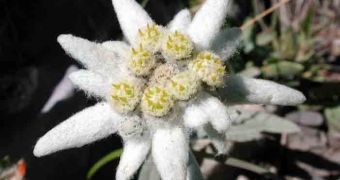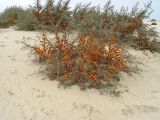There are over 200 species of plants linked to the existence of underground ore deposits.
Plants usually need in low amounts metals for their metabolism. If there is too high the amount encountered in the soil, the plants depose the absorbed excess in their tissues. Sometimes, the deposits can be so big, that when the concentration bypasses 150:1,000,000, the plants can be exploited like ore deposits. The metal is extracted from their ash.
A blackberry species from Latin America contains high amounts of tantalum and niobium. Bigtooth aspen (Populus grandidentata) and milfoil (Achillea millefolium) store zinc. The aspen accumulates zinc in 250:1,000,000 ratio and the milfoil 4,500:1,000,000 on zinc rich soils.
Thus, one ton of aspen green mass delivers 250 grams of zinc, and milfoil about 4 kg (9 pound).
Yellow calamine violet (Viola calaminaria) is an indicator of zinc ore deposits. An expert geologist can assess the concentration of zinc based on the plant's petal colors. Agglomerations of a species of pennycress (Thlaspi calaminarium), when reaching more than normal sizes, are also indicators of zinc deposits.
Magnesium rich rocks are preferred in Europe by species of spleenworts fern species (Asplenium adulterinum and A. cuneifolium serpentini), alpine cinquefoil (Potentilla crantzii serpentini), a forget-me-nots (Myosotis suaveolens gayerii)(from Hungary), a stonecrop (Sedum serpentini), a spurge (Euphorbia serpentini), a sea thrift (Armeria maritima serpentini) (from Germany), a flax (Linum dolomiticum) and a catchfly (Silene elisabethae).
Specific growths on the birch bark signal the presence of an ore with a great concentration of cobalt.
The violet "sleep flower" from Urals Mountains indicated the presence of an underground deposit of nickel. In the Carpathians mountains, the aluminum rich bauxite deposits are betrayed by agglomerations of wintergreen (Chimaphila umbellata).
Some carnation species from the Altai Mountains are connected to the presence of underground copper ore deposits.
Copper deposits are discovered in Zaire with the help of the copper flower (Haumaniastrum robertii), which also accumulates cobalt. In Zimbabwe and Zambia, copper deposits are detected with the help of a basil species, Ocimum homblei.
In North America, the main lead ore indicator is the leadplant (Amorpha canescens), a forb related to the beans, and in Nevada a species of milk-vetch (Astragalus pattersoni) indicates with great precision uranium deposits.
Some heat loving plants always indicate the presence of the limestone, like edelweiss (Leontopodium alpinum), alpine forget-me-not (Eritrichium nanum) or alpine toadflax (Linaria alpina). Other plants indicate the cold flint rocks, like crenate buttercup (Ranunculus crenatus), glacier buttercup (R. glacialis), a saxifrage (Saxifraga cimosa), a catchfly (Silene lerchenfeldiana) and a cinquefoil (Potentilla haynaldiana).
A strange bush, sea-buckthorn (Hippophae rhamnoides) presents an affinity for ?oil. The bush is not a special indicator of the oil, but oil comes in many cases accompanied by two minerals: gyps and salt, which are preferred by the sea-buckthorn, that's why the plant looks for the terrains where is a great probability of encountering oil.
Also, getting rid of contaminated soil of heavy metals, like nickel, lead, zinc, and cadmium can be made using metal-loving plants. They absorb the metals from the soil, storing it in their leaves, stems and other aerial parts. The plants can be processed and some more precious metals recovered.

 14 DAY TRIAL //
14 DAY TRIAL // 
